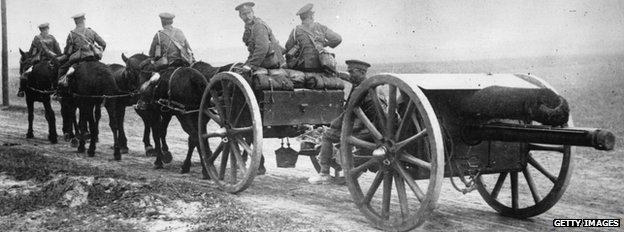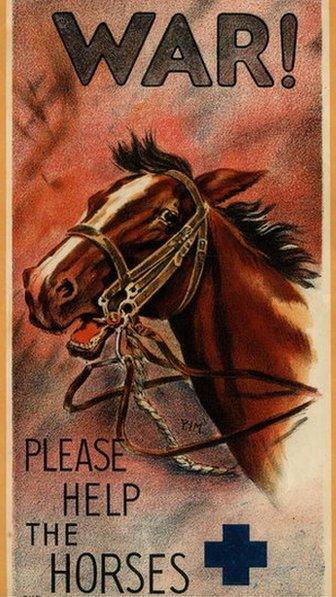World War One: The circus animals that helped Britain
- Published

Lizzie the elephant became a regular sight on the streets of Sheffield during World War One
As World War One raged, the military purchased most of England's horses and sent them to the Western Front. Many farmers and traders had to find alternative beasts of burden, but none more exotic than elephants.
On the cobbled streets of industrial Sheffield an Indian elephant dutifully lumbered along.
Her task was important - she had to cart munitions, machines and scrap metal around the city, a job previously done by three horses taken off to war.
Lizzie - as she was known - was used to performing tricks as part of a travelling menagerie.
But with the outbreak of World War One she was conscripted to help with heavy labour, fitted with a harness and sent to work at a scrap metal merchants.
However, she was not the only exotic animal working in Britain.
Camels, most probably from the same menagerie as Lizzie, were also used in Sheffield to pull heavy loads.
And in Surrey, elephants from a nearby circus filled-in for absent horses, ploughing fields and transporting hay.
But how useful were these circus animals to the war effort? And what did people in rural and industrial Britain make of their new co-workers?

Horses bore the brunt of much of the heavy work during World War One, including pulling artillery
The Word's Fair newspaper first chronicled Lizzie's appearance in February 1916, noting the "great dearth of carting facilities in Sheffield" had led to her being "pressed into service" from Sedgewick's menagerie.
It read: "Last week it was seen striding along with ease drawing a load of iron to a munition works.
"The weight of the load was equal to that usually allotted to three horses.
"Some passing horses were startled by this unexpected 'dilution' of their labour, and sniffed and shied as the elephant passed."
According to Sheffield amateur historian, author and illustrator, Clare Trowell, it was not known how she wound up at Tommy Ward's, a ship breakers and scrap metal merchant in the city.
"By 1916 most of their heavy horses had gone to the front," she said.
"Lizzie was an Indian elephant, intelligent and trainable - she would've been used to people because she was part of a menagerie.
"She would've have been traipsing up and down the streets where people lived, it would've been an odd image.
"She was quite a character - there's a story about her putting her trunk into somebody's window and stealing their dinner."
Lizzie was given a special pair of leather boots to protect her feet from the metal rubbish, which littered the ground at the scrap metal yard.
Little is known of her fate after the war, however, an expression "done up like Tommy Ward's elephant", which was used when somebody was carrying something heavy, has survived in the area.
There is also some evidence that she went on to work at a farm where the ground was more forgiving.
And it was this type of work that a group of elephants in the town of Horley, in Surrey, performed during the war.

Elephants from Sangar's Circus were used to plough fields in Surrey
Alan Reid, from the Horley History Society, said: "You grow up thinking elephants are African or Indian animals - so seeing them wandering around Horley in World War One, would've been quite a shock.
"They were heavy animals and would have been very useful pulling ploughs and carrying stuff."
The Horley elephants were from Lord Sanger's Circus, which based itself in the area, when not travelling around the country.
They were used during the war to plough fields in the area and transport agricultural loads around farms.
"They were used for a practical purpose, but it was probably a good bit of publicity for the circus too," said Mr Reid.

The Blue Cross helped care for horses injured in WW1
"About 30 years ago a bungalow was built where the animals were kept and builders found remains of what they thought was a woolly mammoth. The story was spoiled when they found out it was an elephant."
An estimated 1.2m horses and mules were used by the British Army during the war, with about 484,000 dying. During the war the Blue Cross, a British animal welfare charity, raised funds for their treatment.
Steven Broomfield, who is the manager at the Blue Cross' Victoria Hospital, said he was not surprised that elephants came in useful when so few horses were available.
"The horse was still the main way of moving things," he said.
"Most of the field artillery and lighter stuff was all horse drawn - the bulk of heavy lifting was done by horse power.
"They were much more reliable, didn't break down too quickly, were cheap to run and easy to mend compared to early trucks.
"It was not an easy life - an awful lot would've been killed by shellfire or disease.
"But there's a war to win and quite frankly we would be using all the tools and equipment we had to hand, including elephants."
- Published1 November 2010